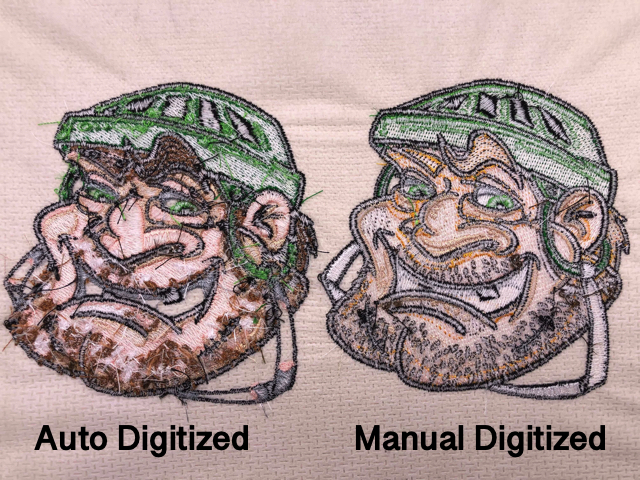Simplifying the Art of Embroidery Digitizing: Step-by-Step Overview
Needlework digitizing is a careful craft that requires accuracy and creative thinking. As technology continues to advancement, the digitization process has become a lot more available, allowing lovers to bring their complex styles to life easily. In this overview, we will unwind the intricacies of embroidery digitizing, damaging down each action methodically to streamline the process and encourage both beginners and experienced embroiderers alike. Remain tuned to uncover how you can streamline this detailed art type and change your innovative visions into magnificently embroidered masterpieces.
Recognizing Needlework Digitizing Software Application
Needlework digitizing software program offers as a critical device for changing complex layouts into digital layouts suitable with embroidery makers, promoting precise stitching and customization. This specialized software permits users to import various picture file layouts, such as JPG or PNG, and convert them right into embroidery machine-readable formats like DST, EXP, or PES - Digitizing for Embroidery. By using features like stitch editing and enhancing, rug options, and string shade selection, digitizing software application enables users to regulate every aspect of the design procedure
Moreover, advanced embroidery digitizing software program provides tools for developing intricate styles, adjusting stitch thickness, and including detailed information. Users can additionally preview the style before stitching it out, ensuring accuracy and minimizing errors. In addition, many software program programs offer automated features that aid enhance the digitizing procedure, saving time and effort.
Comprehending the capabilities of needlework digitizing software program is essential for achieving top notch lead to embroidery projects. By mastering this tool, needlework enthusiasts and professionals can unleash their imagination and bring complex layouts to life with precision and performance.

Selecting the Right Layout File
After familiarizing on your own with the capacities of embroidery digitizing software program, the following important action in the procedure is selecting the ideal style declare your job. Digitizing for Embroidery. When selecting a design declare needlework digitizing, it's important to consider the complexity of the style, the dimension of the end product, and the kind of fabric you will certainly be dealing with
For elaborate designs with fine information, a high-resolution picture or vector documents is suggested to guarantee that the embroidery machine can properly replicate the design. In addition, the dimension of the last product plays a significant duty in choosing the ideal design documents. Larger layouts may require greater resolution files to keep clearness and sharpness.
Additionally, the kind of fabric you will certainly be stitching on affects the selection of style data. Various fabrics may he has a good point need changes in the design file to ensure that the stitches are properly straightened and the style shows up as meant. By very carefully selecting the best design documents based upon these aspects, you can set on your own up for a successful embroidery digitizing procedure.
Digitizing Devices and Methods
Utilizing specialized software and accuracy methods, digitizing devices are important in transforming intricate styles into embroidery-ready files. Needlework digitizing software application, such as Wilcom, Hatch, or Embrilliance, provides the essential system to convert art work into stitch data. These programs offer attributes like stitch editing and enhancing, padding options, and lettering devices to guarantee the layout translates flawlessly onto fabric.
One of the key strategies in digitizing is developing a clear path for the needlework maker to adhere to. This entails digitizing each component of the layout with accuracy, figuring out stitch kinds, thickness, and directions. By making use of tools like digitizing tablets or software-specific plugins, embroiderers can attain a high degree of precision in their digitized layouts.
Furthermore, mastering the art of padding stitching is important for producing top quality embroidery. Underlay sewing maintains the fabric and develops a foundation for the layout, ensuring that the last item is both visually attractive and resilient. By comprehending these digitizing tools and methods, embroiderers can elevate their craft and bring intricate layouts to life with accuracy and performance.
Tailoring Stitch Kinds and Instructions
The option of stitch kinds can significantly influence Look At This the total appearance and structure of the embroidered style. By strategically incorporating these stitch types, embroiderers can achieve depth and dimension in their designs.
Furthermore, the instructions of stitches plays a critical role in boosting the aesthetic charm of the final embroidery. By trying out with different stitch angles and patterns, embroiderers can bring their layouts to life with impressive detail and intricacy.
Testing and Refining Your Digitized Style
To make certain the precision and top quality of your digitized layout, comprehensive testing and refinement are essential action in the embroidery digitizing process. When you have completed the digitization of your design, it is vital to test it before continuing with the real embroidery. Examining enables you to determine any possible problems such as thread breaks, sew thickness troubles, or style distortions that may influence the result.

After testing, it is essential to refine your digitized style based upon the responses from the test sew-out. This may include tweaking sew setups, changing thickness, or making modifications to the total layout to attain the preferred end result. By repeating with screening and improvement, you can tweak your digitized layout to perfection prior to moving on with the real embroidery process.
Verdict
To conclude, grasping the art of embroidery digitizing needs a thorough understanding of the software application, choosing the appropriate layout file, making use of digitizing tools and strategies, personalizing stitch kinds and instructions, and screening and improving the navigate to this website digitized style. By complying with these steps, embroiderers can streamline the digitizing process and create high-quality stitched styles with precision and efficiency.